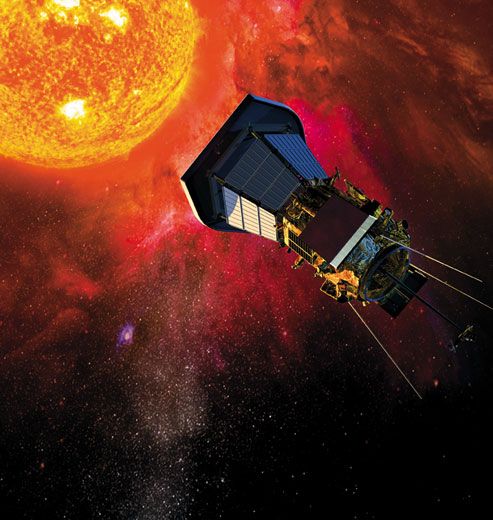New Angles
/https://tf-cmsv2-smithsonianmag-media.s3.amazonaws.com/filer/Castle-Solar-Probe-631.jpg)
Exciting scientific findings abound: a potential bacteria-derived fuel replacement, a planet that orbits dual suns, fossils that link us to our ancestors. Discoveries like these recall the 19th-century explosion of scientific breakthroughs recounted in The Age of Wonder: How the Romantic Generation Discovered the Beauty and Terror of Science, a book by historian Richard Holmes. Because the multidisciplinary Smithsonian approaches research from multiple angles—peering deeply, gazing afar and observing things in completely new ways—we have a distinctive vantage point for understanding future scientific wonders.
The Harvard-Smithsonian Center for Astrophysics (CfA) in Cambridge, Massachusetts, is giving us tantalizing glimpses into the universe’s mysteries. Award-winning CfA astronomer Justin Kasper developed the Solar Probe SWEAP (Solar Wind Electrons Alphas and Protons) instruments for a 2018 NASA probe, which will be the first to enter the Sun’s corona (atmosphere), just four million miles away from the solar surface. These instruments will investigate why the corona reaches a million degrees Kelvin and why its plasma (superheated ionized gases) is whipped into frenzied million-mile-per-hour solar winds.
CfA astronomers are also using the Earth-orbiting Kepler telescope to measure the fluctuations in stars’ brightness that reveal how fast they spin. Since the rate of rotation declines over time, scientists can gauge the ages of stars. This may help identify planets that are the “right” ages for the possible evolution of extraterrestrial life, including species comparable to life-forms on Earth. If we even hope to give E.T. a call, our best bet is to find a planet close to the age of our own world.
Perhaps the most exciting development to emerge from the CfA is one that might save human lives. By combining an electron microscope with a sensitive X-ray detector, CfA scientists have adapted astronomy techniques for use at the human cellular level. This new perspective might someday lead to innovative cancer treatments by allowing researchers to track drugs chemically and distinguish between healthy and diseased cells.
The Smithsonian brings together researchers from various disciplines, leading to unexpected connections, new insights and pioneering discoveries that enrich humanity. Such a multidimensional approach to research is an important reason that Holmes—as I have written before—has said, “If there is a second ‘Age of Wonder,’ I believe it will be driven by the United States of America, and that the Smithsonian will be at the heart of this new possibility.”
G. Wayne Clough is Secretary of the Smithsonian Institution.
/https://tf-cmsv2-smithsonianmag-media.s3.amazonaws.com/accounts/headshot/wayne-clough-240.png)

/https://tf-cmsv2-smithsonianmag-media.s3.amazonaws.com/accounts/headshot/wayne-clough-240.png)